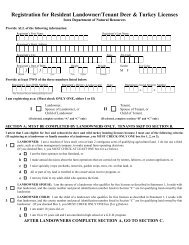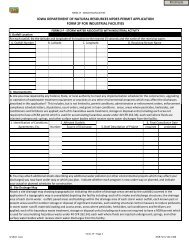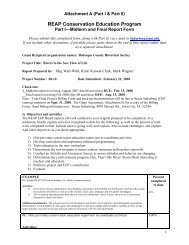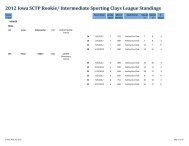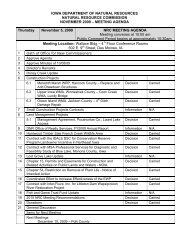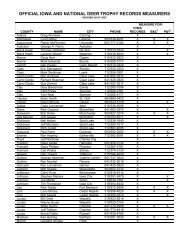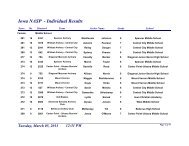Iowa Department of Natural Resources
Iowa Department of Natural Resources
Iowa Department of Natural Resources
Create successful ePaper yourself
Turn your PDF publications into a flip-book with our unique Google optimized e-Paper software.
<strong>Iowa</strong> <strong>Department</strong> <strong>of</strong> <strong>Natural</strong><br />
<strong>Resources</strong><br />
Plastic Water Line Survey Results<br />
Presented By<br />
Tammy Vander Bloemen
Plastic Water Line Pictures<br />
• It is speculated the plastic water line was<br />
weakened by the fertilizer and pesticide.<br />
• Pesticides commonly use petroleum based<br />
solvents.<br />
• The pictures show a plastic water line can be<br />
impacted at locations other than the joints.<br />
• The pipe was 6 inch diameter and SDR 26<br />
(Standard Dimension Ratio).
Industry Survey<br />
• The <strong>Iowa</strong> <strong>Department</strong> <strong>of</strong> <strong>Natural</strong><br />
<strong>Resources</strong> (IDNR) asked six questions<br />
to:<br />
– American Water Works Association<br />
– National Pipe and Plastics, Inc.<br />
– Society <strong>of</strong> Plastics Engineers<br />
– Engineering Systems, Inc.<br />
– National Sanitation Foundation
Industry Survey<br />
• Continued<br />
– American Water Works Association<br />
Research Foundation<br />
– Uni-Bell PVC Pipe Association<br />
– Ductile Iron Pipe Research Association<br />
– American Cast Iron Pipe Company<br />
– Plastic Pipe Institute
Industry Survey<br />
• Question #2 Have you evaluated or<br />
funded research on the impact <strong>of</strong><br />
petroleum on plastic pipe including<br />
polyvinyl chloride (PVC), polyethylene<br />
(PE or black pipe), and polybutylene<br />
(PB)? If so, what was your<br />
determination?
Industry Survey<br />
• Question #3 If you were aware <strong>of</strong> a<br />
utility project passing through a<br />
petroleum contaminated area, would<br />
you recommend the use <strong>of</strong> PVC, PE, or<br />
PB pipe? Or would your<br />
recommendation depend on the<br />
contaminant levels observed in the area<br />
(some studies suggest that PVC pipe is<br />
permeable by petroleum only at<br />
saturated conditions which we assume<br />
to mean free product, or grossly<br />
contaminated conditions)?
Industry Survey<br />
• Question #4 Have you observed or<br />
been made aware <strong>of</strong> any known<br />
problems with petroleum permeation <strong>of</strong><br />
plastic water lines? If so, can you recall<br />
what type <strong>of</strong> plastic pipe was<br />
permeated (i.e.,PVC, PE, PB, HDPE,<br />
etc.)? We are particularly interested in<br />
permeation <strong>of</strong> PVC pipe. If you are<br />
aware <strong>of</strong> any occurrences, can you<br />
recall if it occurred in a grossly<br />
contaminated area?
Industry Survey<br />
• Question #5 Have you observed or<br />
been made aware <strong>of</strong> any known<br />
problems with petroleum permeation<br />
through pipe gaskets? Are you aware<br />
<strong>of</strong> any recommendations for the use <strong>of</strong><br />
special pipe gasket materials in<br />
petroleum contaminated areas?
Industry Survey<br />
• Question #6 Are you aware <strong>of</strong> other<br />
contacts from whom we could acquire<br />
information on this subject?
Industry Summary<br />
• The American Water Works Association<br />
provided the most answers/responses while<br />
the majority <strong>of</strong> the remaining organizations<br />
referred the IDNR to another organization.<br />
The most common referrals were Unibell PVC<br />
Pipe Association and the Plastic Pipe Institute.
IDNR Survey<br />
• The <strong>Iowa</strong> <strong>Department</strong> <strong>of</strong> <strong>Natural</strong><br />
<strong>Resources</strong> (IDNR) asked four questions<br />
to field <strong>of</strong>fice and central <strong>of</strong>fice IDNR<br />
staff.<br />
– #1 Have you observed any known<br />
problems with petroleum permeation <strong>of</strong><br />
plastic water lines?
IDNR Survey<br />
– #2 If so, can you recall what type <strong>of</strong><br />
plastic pipe was permeated (i.e., PVC, PE<br />
(black pipe), HDPE (high density<br />
polyethylene), etc.)?<br />
– #3 If so, can you recall the site? The<br />
contaminant concentration detected in<br />
water samples?<br />
– #4 Does your field <strong>of</strong>fice have any actual<br />
sections <strong>of</strong> the pipe that was permeated?
IDNR Summary<br />
• 24 sites were identified<br />
– 4 were PVC mains<br />
– 4 were PVC service<br />
– 6 were PVC<br />
– 6 were PE Service<br />
– 1 was PE<br />
– 4 were Unknown
IDNR Survey<br />
• Lowest and highest chemical <strong>of</strong> concern<br />
concentrations in water samples<br />
– benzene 1.4 ppb and 2900 ppb<br />
– toluene 1.0 ppb and 13.4 ppb<br />
– ethylbenzene 3.0 ppb and 4.6 ppb<br />
– xylenes 1.0 ppb and 25.6 ppb<br />
– TEH-diesel 200 ppb and 14,000 ppb<br />
– TEH-gasoline 300 ppb and 2400 ppb<br />
– MTBE 1.7 ppb
IDNR Summary<br />
• The IDNR Underground Storage Tank<br />
Section regulates benzene, toluene,<br />
ethylbenzene, xylenes, TEH-waste oil, and<br />
TEH-diesel in soil and groundwater.<br />
• The 2900 ppb benzene was from a<br />
polyethylene (PE) service line to a daycare.
States Survey<br />
• The IDNR sent the state survey through<br />
the ASTSWOMO Network and through<br />
the ITRC State Point <strong>of</strong> Contact<br />
Network.<br />
• 25 states responded to the survey.
States Survey<br />
• Question #1 Does your state evaluate<br />
the impact <strong>of</strong> petroleum on plastic<br />
water lines (PWLs) in your underground<br />
storage tank (UST), leaking UST, water<br />
supply, and/or other section that might<br />
be involved in remediating or permitting<br />
<strong>of</strong> PWLs?
State Summary #1<br />
• Four states have specific procedures for the<br />
assessment <strong>of</strong> plastic water lines.<br />
• Seven states handle these sites on a sitespecific<br />
basis.<br />
• Ten states do not evaluate plastic water lines.<br />
• Four states did not specifically answer the<br />
question.
States Survey<br />
• Question #2 Does your state treat the<br />
different types <strong>of</strong> plastic water lines<br />
such as polyvinyl chloride (PVC) or<br />
polyethylene (PE) differently? If so,<br />
how and why?
States Summary #2<br />
• Six states have procedures for treating<br />
types <strong>of</strong> plastic water lines differently.<br />
• Fourteen states have no procedures for<br />
treating types <strong>of</strong> plastic water lines.<br />
• Five states did not specifically answer<br />
the question.
States Survey<br />
• Questions #3 Have you had any known<br />
problems with petroleum permeation<br />
related to plastic water lines? If yes,<br />
what? Was the type <strong>of</strong> plastic water<br />
line known to be PVC or PE?
States Summary #3<br />
• Thirteen states have known problems with<br />
permeation <strong>of</strong> plastic pipe. Of those thirteen<br />
states, seven states have specifically had<br />
permeation incidents involving PVC.<br />
• Nine states have no known problems.<br />
• Three states did not specifically answer the<br />
question.
States Survey<br />
• Question #4 Do you have procedures<br />
for addressing pipe gasket materials? If<br />
so, how?
States Summary #4<br />
• Five states have specific procedures for<br />
addressing gasket materials.<br />
• Six states handle gasket materials on a sitespecific<br />
basis.<br />
• Eleven states do not evaluate gasket<br />
materials.<br />
• Three states did not specifically answer the<br />
question.
Survey Summaries<br />
• The industry survey did not provide specific<br />
information. People referred IDNR to<br />
different organizations.<br />
• The IDNR survey documents impacts to<br />
plastic water lines do occur.<br />
• The state survey shows plastic water lines are<br />
not evaluated consistently by states.<br />
• The surveys will be posted on<br />
www.iowadnr.gov



